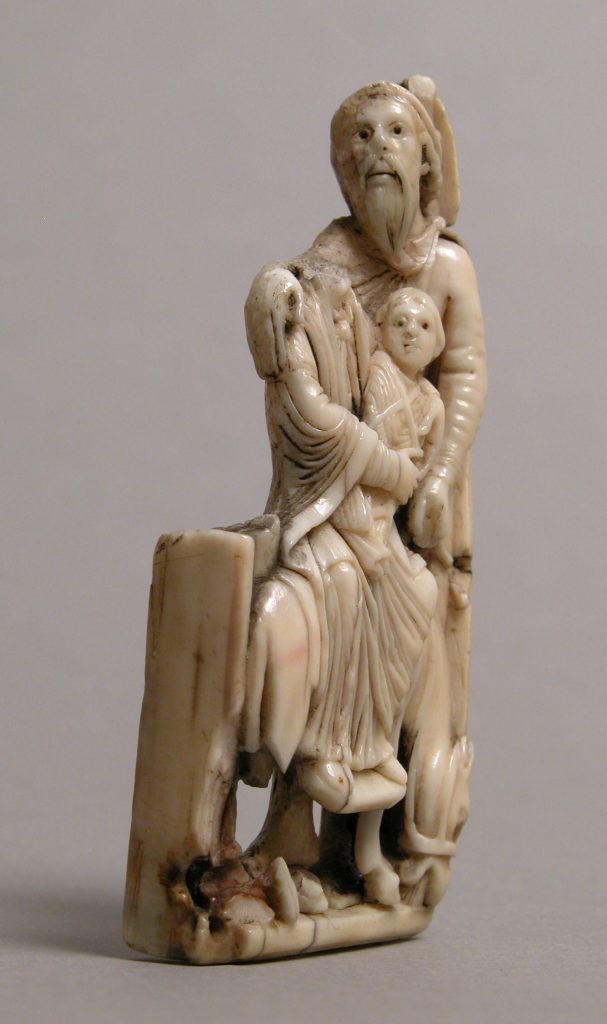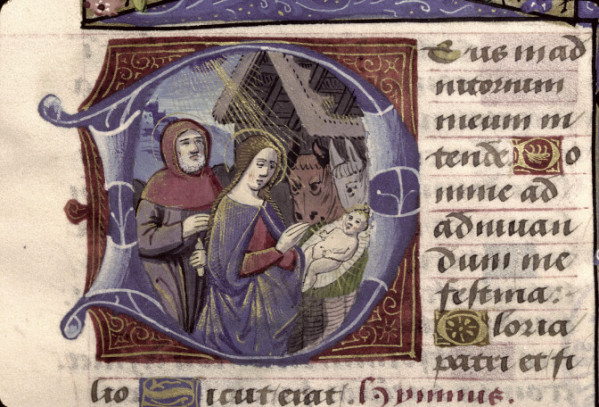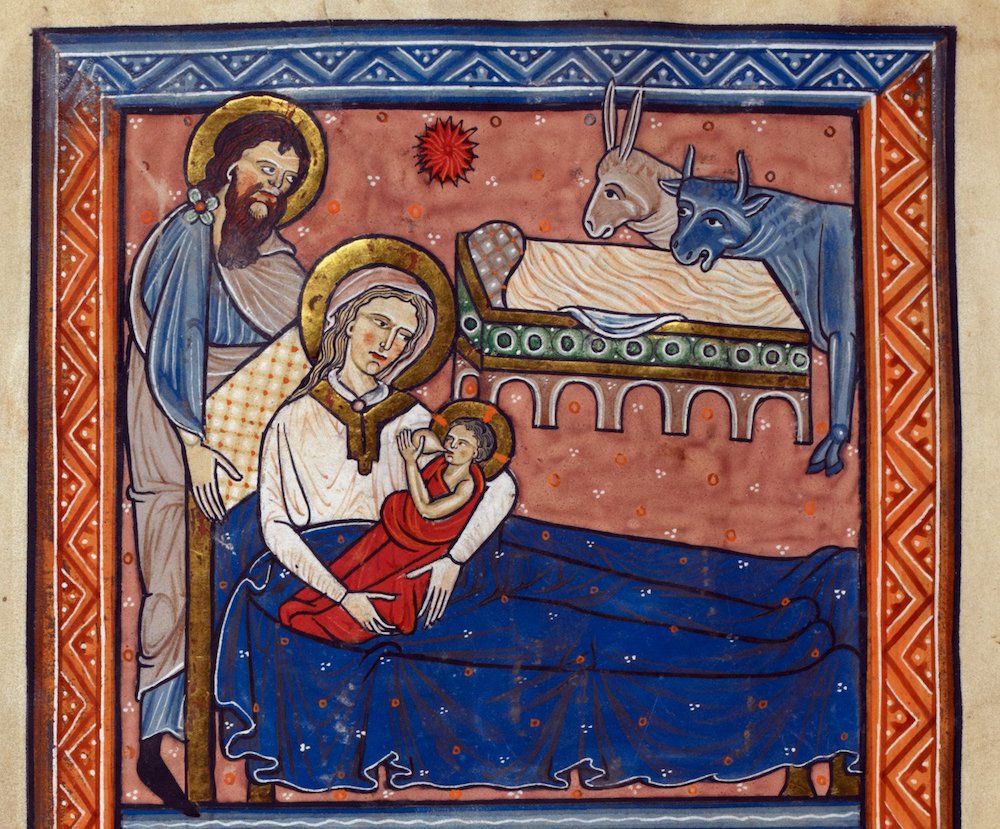The broad outline of the Christmas story is probably familiar to most people, regardless of religious background: Joseph and his heavily pregnant wife, Mary, travelled from their home in Nazareth to the town of Bethlehem. There, unable to find a proper place to stay, they sought shelter with the livestock and Mary gave birth to a son whom she named Jesus.
Throughout the Middle Ages, artists, writers, and scholars frequently returned to the Nativity and its subsequent events—the adoration of the shepherds, the arrival of the Magi from the East—for inspiration and contemplation. Yet the ways in which they explored this story, and the subsequent life of this little family, changed over the course of the Middle Ages. This is particularly true in the case of Joseph, who in the early medieval period was almost ignored in the Latin West, if not treated as an object of ridicule, but who by the mid-sixteenth century was one of the region’s most popular and respected saints. The change in how Joseph was depicted—turning from an elderly quasi-cuckold into a younger, dignified head of household—reflects a shift in how medieval people thought about family life.

Joseph didn’t figure large in the religious imagination of early medieval Christians. When he appeared in artworks, he was mostly a minor figure, and often quite isolated spatially from Mary and the infant Jesus: huddled in a corner of the stable and appearing almost unaware of what was going on. He was a human accessory to the triumvirate of Mary, Jesus, and God the Father; mentioned in the Nativity story, but not really of significance beyond that. After all, he faded out of the Gospels while Jesus is still a boy—perhaps having died—and with no specific place associated with Joseph’s burial, there was nothing to spur pilgrimage and the creation of a saintly cult. Moreover, apocryphal texts like the second-century Gospel of James and the possibly fifth-century Pseudo-Matthew depicted Joseph as an elderly widower who was already a father when he married Mary (thereby “solving” the problem of Jesus’ siblings), and was something of an incompetent.
But as contemporary theology and spiritual practice throughout the High and Late Middle Ages put more emphasis on Christ’s suffering humanity, so too did medieval Christians come to be more interested in Joseph in his role as step-father. In his Commentary on Matthew, the Benedictine monk Rupert of Deutz (ca. 1075-1129) wrote that Joseph, “who, although he was not Christ’s father by flesh, but in faith […] was the greatest of the patriarchs of the Old Covenant and yet in a sense a saint of the New Covenant, because Joseph alone is so close to Jesus, as the husband of Mary and therefore the father of Jesus.” Joseph could function as a bridge between the Old Testament and the New, between the human and the sacred.

This could raise some troubling questions. Several highly influential theologians of the High Middle Ages—like the Italian-born bishop of Paris Peter Lombard (ca. 1096-1160) and the Dominican friar Thomas Aquinas (1225-1274)—agreed with the early Church Father, Augustine of Hippo that there were three elements intrinsic to a legitimate Christian marriage—fides, sacramentum, and proles. This led to worries that Mary and Joseph’s marriage was invalid—faith (fides) was surely present, as was sacramentum (a marriage invested with grace), but what about the lack of offspring (proles)? If, as many believed, Mary and Joseph remained virgins for the entirety of their marriage, was their union legitimate? And just as worryingly, how could a man with no biological heirs, and implicitly no virility, be a proper pater familias (male head of the household)?
The Dominican friar and bishop Albertus Magnus (ca. 1200-1280) countered this by arguing that Joseph had named Jesus—a father’s prerogative—and had cared for him, allowing him to be be considered a true father, and thus his marriage to Mary a whole one. Joseph’s participation in Jesus’ circumcision and in the Presentation in the Temple also functioned as public acknowledgement of paternity. This put a brand new emphasis on fatherhood as something you practised, not just something you were.
These changing ideas about Joseph, family, and marriage filtered through to the general public in a variety of ways. The Spanish Dominican friar Vincent Ferrer (1350-1419) wrote a sermon in which he advanced a hypothetical scenario about Jesus’ childhood, inspired by the adult Christ’s saying in the canonical gospels that he “came not to be served but to serve“. One morning, Mary wanted to go get water from the well, Joseph offered to go instead of her to ease her workload, and each one’s desire to relieve a burden from the other left them in a kind of well-intentioned stand-off (sic pie contenderent Virgo et Joseph). Jesus then takes the task on himself, in order to inspire other children to obey and serve their parents.
St Francis of Assisi and his namesake order famously promoted interest in the Nativity, with Francis purportedly creating the first live Nativity scene in 1223. The Franciscans were also interested in Joseph in his own right, particularly the fact that he had worked as a carpenter. They used Joseph and his profession as a focus for meditation on the humble circumstances of the Holy Family, and thus of Christ’s childhood.

As popular perceptions of Joseph began to change—to emphasise the fact that the Gospels described him as taking on the social role of father to Jesus, even if Christians believed he was not biologically so—so did the ways in which Joseph was shown in medieval artwork. For example, a piece of sculpture from late medieval Burgundy shows the infant Jesus in his crib tended by angels, Mary on her knees in prayer—and Joseph sitting at the hearth, holding the child’s clothes up before the flames to warm them. Medieval households were busy and labour-intensive place, and depictions of the Holy Family often reflect this—Mary busy with textile work, Joseph with his carpentry.
Other late medieval depictions of Joseph—in artwork or in plays—show him engaged in activities that are positively domestic: cooking baby food, bathing the infant Christ, changing the baby’s nappies, even cutting up his own stockings in order to make swaddling clothes for the newborn. In a sermon, Bernard of Clairvaux wrote that this exalted Joseph over many kings or prophets, because he was able “to carry [Christ], to take him by the hand, to hug and kiss him, to feed him and keep him safe.”
There were ways in which Joseph and his circumstances could still be played for laughs with a medieval audience, with his household duties depicted as undignified or unmasculine. In the fifteenth-century northern French play Mystère de la Passion, the circumcising priest asks Joseph if he is indeed the child’s father (Beau preudons, estes vous son pere?), to which Joseph replies “Indeed, I married his mother” (Certes, j’ay epousé sa mere). It’s impossible to imagine this line being delivered with anything other than a knowing wink to the audience.
Still, esteem for the saint increased sharply overall. In the early Middle Ages, Joseph was a highly uncommon name. On a list of 53,000 Tuscan householders collected before 1530, only one “Giuseppe” appears; yet by the 1550s, Joseph had become the patron saint of a number of Italian cities, and across Europe variants of Joseph were used as baptismal names.

For late medieval Christians, Joseph came to represent a model of fatherhood as guardianship, and a paradigm of lay male virtue. A fifteenth-century German “cradle play” (Kindelwiegenspiele) featured Joseph and Mary singing a duet as Joseph rocked the infant Jesus in his cradle:
Mary: “Joseph, dear husband mine, help me rock the little one.”
Joseph: “Happily, my dear little wife, I’ll help you rock the little child.”
Mary: “Take the cradle in your hands and allow my child to be known and rock him nicely so that he doesn’t cry.”
In his tender care for the baby he would publicly acknowledge as his son, in the ways in which the actions attributed to him linked nurturing with masculinity and authority, Joseph helped to create an ideal of the family that could be at once holy and familiar, divine but resolutely human.
